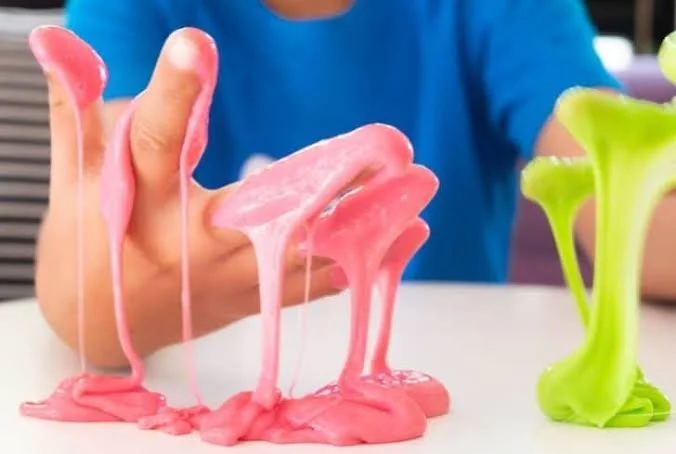Step into the ooey-gooey world of slime sensory play! If you’ve ever encountered slime, you know how fascinating and captivating it can be.
But did you know that this squishy substance also has incredible benefits for children’s development?
From improving fine motor skills to enhancing sensory processing, slime is more than just a sticky mess – it’s a valuable tool for learning and growth.
In this blog post, we’ll dive deep into the wondrous realm of slime and how it can positively impact your child’s development. So stretch, squeeze, and explore the endless possibilities with slime!
What is Slime Sensory Play?
Slime sensory play is a hands-on activity that engages children in an exciting and tactile experience. It involves using a slimy substance from simple ingredients like glue, water, and a slime activator such as borax or contact lens solution. The result? A malleable material with endless possibilities for exploration.
When kids interact with slime, they stimulate their senses in various ways. They can feel the cool texture between their fingers, see the vibrant colors swirling together, and even smell different scents if they add them to the mix.
This multi-sensory experience captivates their attention and enhances their overall sensory processing abilities.
Moreover, slime offers an excellent opportunity for children to develop fine motor skills. As they squeeze and stretch the gooey substance, they build strength in their fingers and improve hand-eye coordination.
Manipulating the slime also helps refine their grip as they experiment with shaping it into different forms or rolling it into balls.
Benefits for Children’s Development:
A. Fine Motor Skills
One key benefit of slime sensory play is its ability to improve children’s fine motor skills. When they engage with slime, kids must use their hands and fingers to manipulate and explore the texture.
This helps them develop strength and coordination in their hand muscles, which is essential for writing, drawing, and buttoning clothes.
B. Sensory Processing
Slime also offers numerous benefits for children’s sensory processing development. As they squish, squeeze, or stretch the slime, it provides different tactile sensations that stimulate their senses.
This can be particularly helpful for children who struggle with sensory sensitivities or those on the autism spectrum.
C. Creativity and Imagination
Engaging in slime play allows children to tap into their creativity and imagination. They can mold the slime into various shapes or mix colors to create new shades. This open-ended play encourages problem-solving skills and divergent thinking – coming up with multiple solutions or ideas.
Through these multi-sensory experiences with slime, children can enhance their cognitive abilities while having fun! So, the next time you’re looking for an activity that promotes learning and enjoyment, consider incorporating slime sensory play into your child’s routine.
A. Fine Motor Skills
Fine motor skills are essential for children’s development and can be improved through various activities, including slime sensory play.
This type of play involves squishing, stretching, and manipulating the slimy substance, which requires precise finger movements and hand-eye coordination.
When children engage in slime sensory play, they use their fingers to explore the texture and consistency of the slime.
They can squeeze it between their fingers or roll it into a ball, enhancing their fine motor skills as they refine their grasp and release abilities.
Furthermore, playing with slime helps children strengthen their hands and fingers. As they knead, twist, and mold the slime, they exercise the muscles needed for writing or scissors. These repetitive motions also improve dexterity and control over small objects.
B. Sensory Processing
Sensory processing is a crucial aspect of a child’s development, and slime sensory play provides an excellent opportunity to enhance this skill.
Engaging with slime exposes children to different textures, temperatures, and consistencies, stimulating their senses in diverse ways.
When children explore slime through touch, they receive valuable tactile input that helps them develop their sense of touch. Slime’s squishy and stretchy nature allows them to experience various sensations on their hands and fingers.
This kind of sensory stimulation strengthens the neural pathways responsible for interpreting touch signals from the environment.
Moreover, playing with slime also engages other sensory systems, such as vision and proprioception. As children manipulate the slime with their hands or tools like cookie cutters or straws, they visually track its changes in shape and color. This visual feedback enhances their ability to process visual information effectively.
Additionally, playing with slime can support proprioceptive processing—the sense of body awareness and position in space.
When children squeeze or pull on the slimy substance, it provides resistance that stimulates proprioceptors in muscles and joints. This input helps develop spatial awareness and muscle strength.
C. Creativity and Imagination
One of the most significant benefits of slime sensory play is its ability to stimulate creativity and imagination in children.
Slime can be transformed into any shape or form, allowing kids to let their imaginations run wild. They can mold it into animals or objects or even create their own unique designs.
This type of open-ended play encourages children to think outside the box and develop innovative ways to play with slime.
They can mix different colors, add glitter or beads for texture, and experiment with various textures and consistencies. The possibilities are endless!
Engaging in creative play with slime also helps enhance problem-solving skills as children determine how to manipulate the material to achieve their desired outcome.
It fosters critical thinking as they explore cause-and-effect relationships and test different techniques.
Furthermore, playing with slime provides an outlet for self-expression. Children can use it as a tool for storytelling by creating scenes or characters using the colorful, gooey substance.
This imaginative play allows them to express themselves freely while developing language skills through storytelling.

